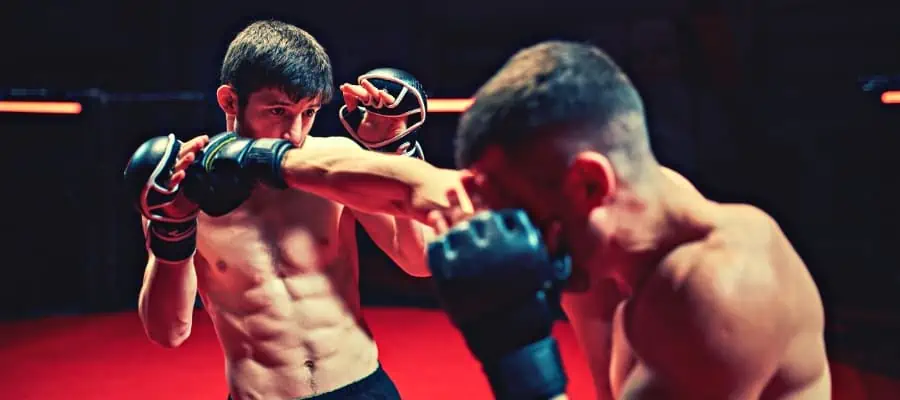Grappling is an umbrella term used to describe the art of controlling your opponent using a combination of takedowns, throws, submission maneuvers, and pins. Wrestling is a subset of grappling, but in modern times, the word “grappling” is often used in martial arts styles such as JudoJudo and jiu-jitsu. Depending on who you ask, they’ll recommend one style over the other- each has advantages.
So, should you choose wrestling or grappling? Freestyle and Greco-Roman wrestling emphasize takedowns and footwork from the standing position while simultaneously preventing your back from getting pinned. In contrast, having your back against the ground is often considered an advantage in grappling styles like Brazilian jiu-jitsu, as it sets up a variety of chokes and submissions.
Modern MMA fighters typically have a wrestling or jiu-jitsu background and often mix moves from both styles. They have a wrestling base, which helps them build strength and explosive power to get opponents on the ground. This is combined with jiu-jitsu to help them fight from the ground and on their back, utilizing the triangle choke, armbar, guillotine, etc.
| Wrestling | Grappling | |
|---|---|---|
| What it is | A type of full-contact combat sport that involves the use of takedowns and throws to control your opponent and gain an advantageous position | An umbrella term that refers to the art of controlling your opponent’s movement using a combination of clinch holds, throws, trips, and submission maneuvers |
| Origins | It’s an extremely old sport, the earliest depictions of which can be found in cave drawings from France. Babylonian and Egyptian sculptures also depict various wrestling moves that are still used today. | Grappling as a concept dates back to the earliest days of wrestling (several thousand years ago), and is mentioned in historical literature like the Bible, Indian Vedas, Iliad, etc. |
| Used For | Lifting your opponent clean off their feet and slamming them into the ground, then keeping them pinned down with your body weight and leverage. | Grappling contains a lot of submission moves and chokeholds that aren’t present or permitted in freestyle/Greco-Roman wrestling. |
| Popular Styles | Freestyle, Folkstyle, Greco-Roman, Shuai Jiao. | Brazilian Jiu-Jitsu, Judo, Sambo, Catch Wrestling. |
| Strengths | Explosive power, controlling your opponent with leverage, takedowns, breaking out of disadvantageous positions. | Wide variety of submission maneuvers for different situations, the ability to fight while your back is on the ground, and works well in street fights. |
| Weaknesses | A lack of submission maneuvers doesn’t teach you how to fight against someone with your back to the ground. | Grappling arts like BJJ and Judo work well in street fights. Once the fight goes to the ground, grapplers have an advantage. |
| Street Fight Viability | With wrestling, you can take down an opponent and strike them while they’re on the ground. | Grappling arts like BJJ and Judo work well in street fights. Once the fight goes to the ground grapplers have an advantage. |
| Physical Conditioning | Wrestlers are quite tough, capable of exploding with short bursts of immense strength, and have superior agility despite their size. | Generally speaking, BJJ fighters are less physically conditioned than their wrestler counterparts. |
Wrestling vs. Grappling – Find Your Perfect Combat Style!

The two complement each other, and everyone who wants to be a well-rounded fighter should train in both wrestling and BJJ. In fact, that’s what most modern MMA fighters do- they combine wrestling with BJJ for the ultimate in grappling skills. You don’t have to be a black belt in BJJ, nor do you have to be an Olympic gold medalist wrestler.
However, it really helps to know the basics of both styles. This way, you have an advantage over your opponents, whether the fight is standing or on the ground. When you combine grappling skills with striking skills (boxing), you become a formidable opponent in any kind of fight- inside the ring or on the streets.
If you’re going to learn wrestling, the best time to start is when you’re still young. Wrestling training programs are extremely gritty; you spend all day rolling on the mat with your fellow students. Not only that, but you must also condition your body to gain the agility and explosive power expected from a wrestler.
Unlike BJJ or Judo, wrestling places equal emphasis on technique and power. Conditioning your body for wrestling involves strength training (weights) and cardio. There will be many barbell squats, lunges, hammer curls, bench presses, crunches, etc.
Even school/college-level wrestling programs involve much more physical conditioning than your average BJJ gym. Sure, the ones that train UFC, ADCC, and IBJJF fighters have a very strenuous training regiment. But generally speaking, you want to start wrestling training as early as possible to avoid stress-related injuries.
How Do Wrestlers Get So Strong?

Of all the combat sports, none places as much emphasis on physical conditioning as wrestling. Not only are wrestlers built tough and incredibly strong, but they are also very athletic and agile for their size. A wrestler can take you down and lay you on your back in seconds but can also roll around on a mat for hours on end without blacking out.
To be a wrestler, you must have a strong core and tremendous hip and leg strength. A lot of the rotational force that is required to toss a grown person across the mat comes from your hips and core. Plus, you must regularly grapple with your fellow students on the mat for hours while maintaining a strict diet that provides sufficient proteins and carbs.
The Ideal Body Type for Wrestling

It’s hard to pinpoint the exact body type you need to be a champion in wrestling. Still, it’s widely known that the best wrestlers have low body fat and lots of muscle, especially in their lower body, consisting of the hips, thighs, and calves.
The best wrestlers aren’t very tall, even though height can give you an advantage simply by providing longer muscles that generate more force. The high mass combined with a low height-to-weight ratio means that wrestlers usually have a mesomorph or endomorph body type.
Does Grappling Make You Stronger?

Most grappling styles focus on technique rather than raw power, except for wrestling, which emphasizes strength and agility. For example, JudoJudo is more about using your opponent’s momentum against them rather than overpowering people with your own body. Judo is so good at disabling larger opponents, especially those wearing loose-fitting clothes.
Is it Better to Learn Grappling or Striking?

Grappling helps you take down your opponent and control their movement with the help of sweeps, trips, clinch holds, etc. Striking is done when you’re on your feet, throwing punches and kicks at your opponent. Top striking disciplines include boxing, karate, and Muay Thai, while top grappling disciplines include wrestling and BJJ.
Certain styles that focus on striking also incorporate elements of grappling. For example, Muay Thai has clinching and sweeps. Power and speed are important in striking, but technique reigns supreme in grappling.
Once the fight goes to the ground, grappling is your best weapon. It contains a variety of chokes, submissions, and joint locks that cause enough pain or discomfort that your opponent will tap out or go to sleep. However, grappling is a poor choice when you’re faced with multiple opponents- usually the case in a street fight.
Conclusion
I hope this article helped you understand a little bit more about the similarities and differences between wrestling and grappling. While wrestling can be considered a subset of grappling, the modern definitions make it such that grappling is associated with BJJ and Judo. Recently, BJJ schools have been incorporating takedown moves from wrestling.
Wrestling has superior takedowns and lets you slam your opponent into the ground with great speed and power. Grappling arts like BJJ are more geared towards submission maneuvers that can be executed once you find yourself with your back against the ground. BJJ also has moves that let you control your opponent’s neck once you get behind them (like the rear naked choke).
If this article was helpful to you, don’t forget to add it to your Pinterest board.
Recent Posts
What is Manachai's Fighting Style? Unveiling Muay Thai Mastery
Manachai, a celebrated figure in the Muay Thai world, has captivated audiences with his exemplary martial prowess. Hailing from the heartlands of Thailand, his name is synonymous with the art of...
What Was Chamuekpet Hapalang's Fighting Style? Unveiling Techniques
Chamuekpet Hapalang was a renowned figure in the world of Muay Thai (record 200-48-2), embodying a fusion of Muay Bouk and Muay Khao styles. Originating from Thailand, the art of Muay Thai is known...

